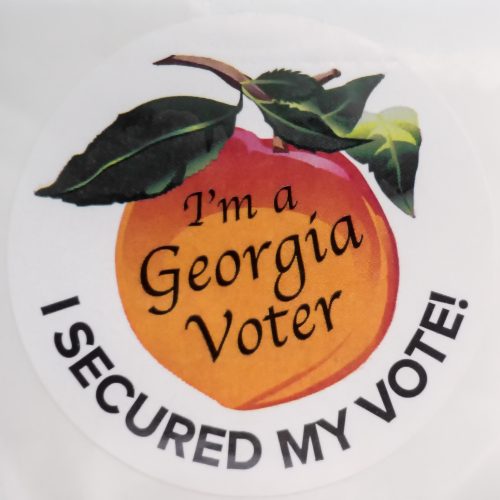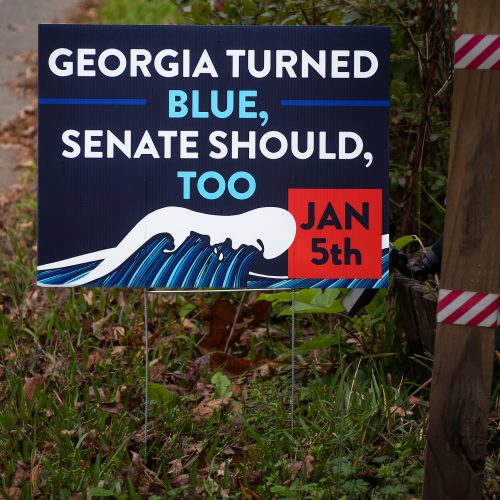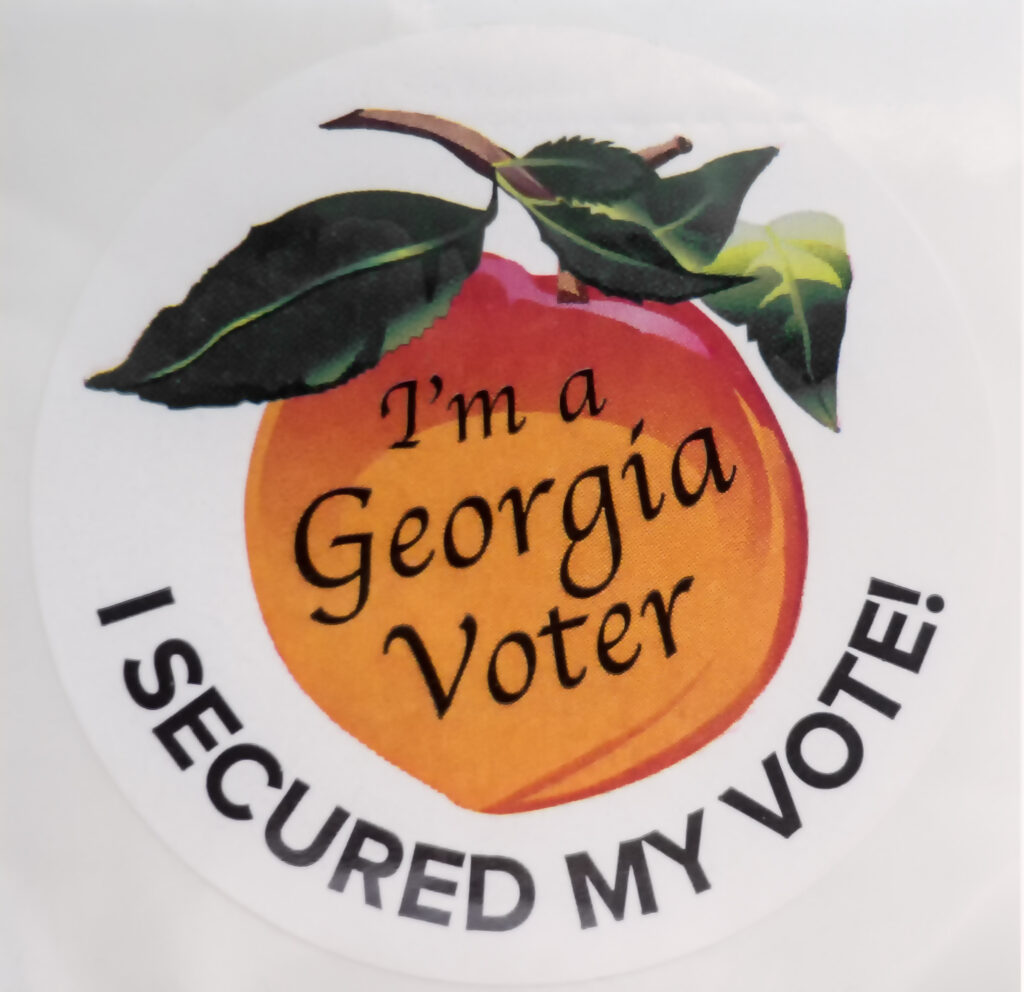By: Dr. Elisa Lanari

On January 6, 2021, as a mob of white Trump supporters stormed the US Capitol, voters in Georgia—particularly Black voters—inaugurated a new era by electing Raphael Warnock and Jon Ossoff to the US Senate, delivering a key victory for Biden and the Democratic Party. While confirming the status of Georgia as a new battleground state, the elections also revealed that this battle is increasingly being fought in the suburbs, particularly in once-Republican, majority-white communities now home to growing numbers of Black, Asian, and Latinx residents. If the ideological and political chasms dividing many suburban and rural areas around Atlanta have been said to mirror those of the nation as whole (Willis and Witte 2020), one cannot help but wonder: what have we done, as anthropologists, to understand these places and their growing social and political polarization? Have our “blind spots of liberal righteousness” (Smith 2017)—including a geographical prejudice against the US South (Edgerton 2018)—actually prevented us from engaging with these communities and their heterogeneous counter/publics?
Some of these blind spots came to light as I grappled with ongoing transformations in my own field site of Sandy Springs, Georgia. When I first started my project in 2010, this community had just made national headlines as a largely white and affluent suburb that had managed to separate itself fiscally and politically from the city of Atlanta by establishing an autonomous municipality, the first in the US to be almost entirely privatized (Segal 2012)¹. This successful municipalization ushered in a new era of white flight and metropolitan secession in Atlanta (Rosen 2017), one in which the creation of new cities—about a dozen in the span of fifteen years—has emerged as a tool (alongside redistricting, exclusionary zoning, and other well-consolidated strategies) to protect white spatial and material advantages in an increasingly Black and multiethnic metropolis. Given this context, my research was fundamentally concerned with mapping on-the-ground reconfigurations of whiteness and racial capitalism as reflected through Sandy Springs’s decade-long project of neoliberal “city” making.
But as my ethnographic engagement with this community deepened, spanning most of the 2010s, I became increasingly interested in understanding how this exclusionary racial project was progressively being unsettled by suburban diversity. How were Black, Latinx, and Asian newcomers—together representing almost half of Sandy Springs’s current population—transforming these landscapes of (white) privilege? And how did a municipality built to keep out urban “problems” and populations deal with the growth of racialized poverty within its boundaries? These and similar questions ran through my field notes as I divided my time between volunteering for local welfare agencies and Latinx-led organizations, and attending corporate and civic events on topics like “diversity” or the “browning of suburbia.”
"If the ideological and political chasms dividing many suburban and rural areas around Atlanta have been said to mirror those of the nation as whole (Willis and Witte 2020), one cannot help but wonder: what have we done, as anthropologists, to understand these places and their growing social and political polarization?"
To all of those who have followed recent political events in Georgia, the connection between the “blue” wave that has swept through many of Atlanta’s once-Republican strongholds and these areas’ changing demographics will perhaps sound like old news (Fausset 2017). Last November, a Black candidate ran for mayor for the first time in Sandy Springs’s history, supported by organizations like Stacey Abrams’s Fair Fight, which played a key role in fighting voter suppression and increasing minority voter turnout in the 2020 and 2021 elections. While Abrams recently announced her second bid for Georgia’s governor, other candidates of color vied for city council seats in Sandy Springs, with the goal of amplifying “diverse” voices in local politics (Murchinson 2021). Some said they were inspired to run by the death of George Floyd and the events of 2020. That summer, a contingent of about three hundred people occupied the manicured lawns of Sandy Springs’s brand-new “city center” to stage a Black Lives Matter rally—a rather unusual sighting in the privatized, securitized, car-centric landscape of this suburb, yet one that has been increasingly common across the country (Sisson 2020).
So here I am, a decade after my first foray into Atlanta’s suburban worlds, writing about scenarios that I would have never anticipated back then. While it would be tempting to analyze these developments through a narrative of racial progress and anti-Trump mobilization in the “city too busy to hate,” here I would like to take a slightly different route, starting with the paradoxical chain of events of January 6th, 2021. As some already noted after the 2016 elections, analyses that over-emphasize the “angry white male” narrative lose sight of the fact that, among those who participated in the violent mass insurrection of January 6, were many middle-class people with no obvious ties to far-right organizations, hailing from pro-Biden and battleground counties in large metropolitan areas (Gusterson 2021; Ruby and Pape 2021). Furthermore, a majority of Trump supporters in 2016 came from the petite bourgeoisie “who lives and works in close proximity to Trump’s detractors,” in the suburbs and exurbs of progressive, multicultural Sun Belt cities like Atlanta (Smith 2017; see also Carnes and Lupu 2017; Myerson 2017).
White liberal academics have been guilty of subscribing to these narratives, too. In their piercing analysis of the 2016 AAA meetings, Aisha Beliso-de Jesús and Jemima Pierre (2020, 69) note that many white anthropologists turned to their colleagues of color—or, in some cases, to people like myself engaging with US Southern conservatives—to “satisfy their thirst for a post-Trump lamenting,” demanding insights into the minds and behaviors of “strange white extremists” (ibid.) and other “repugnant cultural others” (Carey 2019). This attitude blinds “educated” liberals “from actually understanding and engaging political difference” (Smith 2017), particularly that which manifests itself less blatantly and under a more “respectable” guise. It also betrays a refusal to acknowledge that white supremacy, far from being something that only “other (read: ignorant, poor, or uneducated) white people do” (Beliso-de Jesús and Pierre 2020, 69), is actually much more pervasive, enduring, and non-exceptional in its manifestations (Rosa and Bonilla 2017, 206).
This reluctance to “de-provincialize Trump” (ibid.) returns, under a different form, in the narratives that celebrate the Democratic Party’s success in “flipping” Atlanta’s northern suburbs as an unmistakable sign of these areas’ “increasing embrace of multiculturalism and diversity” (Gabriel and Fausset 2017; Stein 2017). Changing demographics, with the influx of immigrants and out-of-state transplants, certainly played a part in this story. But as I show through the prism of Sandy Springs, these political transformations have not dismantled the overbearing power of whiteness in shaping local discourses, affects, and policies. Rather, they are a symptom of a shifting and increasingly fractured white suburban commonsense.

“Diversity is staring at us in the face!”
“Suburban women, can you please like me? I saved your damn neighborhood!” With these words, uttered during a campaign rally in Johnston, PA (Axelrod 2020), Donald Trump tried to convince white voters—especially “suburban housewives” (Yglesias 2020)—that his law-and-order approach and repeal of Obama-era fair housing policy had “saved suburbia” and the race- and class-specific version of the American Dream it embodied.
Judging from its history, one would think Sandy Springs to be the perfect place for Trump to rally votes through this recently revamped suburban strategy (Barbaro 2020). For over thirty years, local residents fought to obtain independent cityhood so as to protect their single-family neighborhoods from unwanted zoning of apartments and federally mandated busing programs. They couched these stances in the thinly veiled language of post-Civil Rights white racial resentment, the same used by Goldwater and Nixon in their 1970s-Southern suburban strategy (which Trump has tried so clumsily to reanimate).
These local suburban mobilizations, as others that took place across the US South and Southwest in the 1970s (Kruse 2005; Lassiter 2006; McGirr 2001), served as a breeding ground for the national political realignments of the following decades and the consolidation of modern conservatism. In the 1980s, voters in Sandy Springs elected congressman Newt Gingrich, future Speaker of the House and protagonist of the 1990s Republican Revolution, whose “hardball” rhetoric and divisive political style helped pave the way for Trump’s success (Coppins 2018; Kornacky 2018). Gingrich’s rallying cries against “Atlanta’s welfare state” resonated well with Sandy Springs’ quest for fiscal and political independence, which reached its culmination on November 1st, 2005, when the area was finally able to incorporate as an autonomous municipality. Upon starting what the newly elected mayor called a “wonderful civic adventure of self-government” (“Sandy Springs” 2005), the city also embarked on a major experiment in government privatization. By outsourcing nearly all of its services to a multinational corporation, Sandy Springs became a poster child for Bush-era shock doctrines (Klein 2007) and anti-“big” government crusades.
Echoes of this decade-long history reverberated through my fieldwork, which featured countless interactions with people whose right-wing political beliefs seemed so self-evident that they rarely became the object of conversations. (And when it happened, it was usually to test my allegiances as a foreign researcher affiliated with a prestigious university in the urban Midwest: was I trying to gain a “political perspective” on behalf of Chicago’s “liberal academia,” or did I have no stakes in the fractured world of US politics?)
"But as I show through the prism of Sandy Springs, these political transformations have not dismantled the overbearing power of whiteness in shaping local discourses, affects, and policies. Rather, they are a symptom of a shifting and increasingly fractured white suburban common sense."
But something began to change in the months leading up to the 2016 US presidential elections. All of a sudden, many of my white, middle- and upper-middle class female interlocutors seemed eager to discuss national politics. Some confessed that their Republican beliefs were being put to the test, while others made references to attending local fundraisers for Trump. Yet it was the (formerly closeted?) Democrats who became especially vocal. Among them was Sandra, a fifty-something white divorcée working for a local charitable organization, whom I interviewed in June 2016. As we were nearing the end of our conversation, Sandra suddenly fell silent. Then, she referred to an event we both attended a few days earlier, a public talk on the “browning of America” and its consequences for Atlanta’s suburbs. “This is how things are going to be, you know, it’s a trend,” she stated confidently, her tone becoming more agitated as she veered towards politics. “But then, you know, we have this presidential candidate who wants to build a wall between Mexico and the US. That’s ridiculous! Diversity is staring at us in the face!”
For Sandra, the experience of volunteering with Latinx children at a local Title I school had been eye-opening, helping her realize how much her community had changed and spurring her involvement on issues of poverty and social justice. The elections amplified those stances. In January 2017, after Trump had carried Sandy Springs by a very narrow margin, Sandra joined the Women’s March in Atlanta. Later that year and the following, she supported Jon Ossoff’s and Lucy McBath’s attempts at flipping Georgia’s Sixth District, a goal which McBath achieved in 2018, becoming the first Black woman to represent the district.
Both in Atlanta and elsewhere, suburban women of all backgrounds—including the white women to whom Trump was so desperately trying to appeal—were key in mobilizing the votes that allowed Democrats to win historically red districts and regain control of the House. Media analyses portrayed these women as having “live[d] politically somnambulant lives” and experiencing a sort of political awakening in the aftermath of Trump’s elections, which led them to “transform themselves and their communities through unceasing political engagement” (Traister 2017; see also Goldberg 2017; Rubin 2017).
Yet Sandra and many others I met during my fieldwork had been involved in local community activism for decades, for instance, as founders and leaders of local nonprofits focusing on education, civic leadership, social services, and much more. In the 1980s and 1990s, their grassroots and fundraising work had been crucial to supporting the movement for municipal incorporation. In the 2000s, as the city started to undergo demographic changes, these women devoted their energies to creating privately funded social programs for low-income families, immigrants, and “at-risk” youth.
While largely dominated by the neoliberal white logics of volunteerism and philanthropy, these initiatives also contained the seeds for moments of reckoning and ongoing political transformations. For instance, let us consider the case of Isabelle, an upper middle class white woman whose charity had been one of the major drivers behind these social programs. In 2019, after the local administration failed to listen to citizens’ concerns about a redevelopment plan that would threaten to displace Black and Latinx working-class families, Isabelle started to worry about the need to “maintain diversity” in a gentrifying Sandy Springs. She thus joined forces with other Black women and community leaders in creating an organization that has been advocating for affordable housing and for including other less-represented voices—such as those of apartment renters—in decisions about the city’s future.
Last year, following the Black Lives Matter rallies, the organization focused its efforts on engaging residents and administrators in open conversations about racial justice and inequality. By pushing these topics through local political discourse, these initiatives have been slowly chipping away at the hegemony of coded racist language about housing, property, and privilege, exposing connections between present inequities and “convenient, collective amnesias” about the city’s past (Kruse 2005, 258).
Times are changing, but are they?
Coded language and dog-whistling politics, however, have not disappeared. As a matter of fact, they resurfaced even more strongly as new publics have appeared on the political scene. During the recent campaign for municipal elections, Black candidates were targeted by email threats and hostile media posts associating them with crime and alluding to their support for the Black Lives Matter movement. A flier distributed by the Republican party juxtaposed stock photos of the Baltimore protests with allusions to supposed threats to the city’s public safety and financial stability, claiming: “We can’t let Sandy Springs turn into another Atlanta” (Bluestein and Brasch 2021).
These attempts at appealing to the same anti-Atlanta sentiments and racially motivated fears that drove the municipal battle for incorporation show that anti-Blackness and white supremacy remain deeply entrenched within local political language and sensibilities. Some things have changed: in the days following these incidents, white residents joined Black candidates in denouncing instances of racism, spurring conversations around these discursive tactics and their historical roots. Others have not: most of the other candidates did nothing to condemn these actions, and some even denied that racism had anything to do with these episodes—again borrowing a page from the cityhood movement’s playbook.
But when it comes to denying racism and holding on to white privilege, there are many other shades and positions along the spectrum. As historians Michan Connor and Matthew Lassiter have suggested on different occasions, the fact that some suburban white voters were not enticed by Trump’s appeals, but rather supported Democratic candidates in growing numbers, might be more revealing of their “acute discomfort at racism dragged in the open” than of a sweeping change in their social and political views (Connor 2017; Lassiter in Badger and Cohn 2020). My research has extensively documented these feelings of discomfort, showing that, when it came to setting policies and priorities surrounding issues like housing, schooling, “diversity” and inclusion, most people were not ready to see their racial privileges challenged. They were, however, increasingly preoccupied with not appearing “like a bunch of rich white racists” (as one of my participants told a journalist from The Atlantic), even more so in the Trump era.
Rather than reproducing dichotomous oppositions between “bad white people” and those who have been enlightened by the experience of living in denser and more diverse communities, then, anthropologists should attend to how these transformations might be leading to both an unsettling and a retrenchment of suburban whiteness. Our discipline has provided insights into white suburbanites’ racial and class anxieties and desires for security in the late capitalist era (Gusterson and Besteman 2009; Heiman 2015; Low 2003). It has also offered a rather modest contribution to growing scholarship on immigrant suburbs (Aparicio forthcoming; Mahler 1995). Yet I would argue that we still lack a meaningful engagement with the people, social and cultural forces reshaping suburban politics in Atlanta as elsewhere—particularly one that considers insurgent publics and resurgent white politics in the same ethnographic and analytical framework.
Following the original intent of this Home/Field intervention, I thus would like to extend an invitation to those whose research and praxis is based in these communities, to contribute to these ongoing dialogues.
¹From day one of its operations through 2019, Sandy Springs outsourced all of its services (with the exception of fire and police departments) first to one global consulting firm, and then to multiple private contractors. For more details on this public-private partnership model, see: Lanari 2019; Porter 2006; Segal 2012.

Dr. Elisa Lanari
Dr. Elisa Lanari (PhD, Northwestern University, 2019) is a cultural anthropologist and postdoctoral research fellow at the Max Planck Institute for the Study of Religious and Ethnic Diversity.
Bio
Her research on race/ism, migration, and inequality spans across multiple geographies—from small-town Italy to the suburban US South. She has written about gentrification and Latinx suburban activism in City & Society and Citizenship Studies. Her first book manuscript, Re(In)surgent Suburbia, combines history and ethnography to explore the capitalist racial projects and emerging political possibilities of Atlanta’s diversifying suburbs.
You may republish this article, either online and/or in print, under the Creative Commons CC BY-ND 4.0 license. We ask that you follow these simple guidelines to comply with the requirements of the license.
In short, you may not make edits beyond minor stylistic changes, and you must credit the author and note that the article was originally published on Home/Field.
Image Credits
Title: “I Secured My Vote.”
Creator: Thomas Cizauskas
Source: Flickr
Copyright License: CC BY-NC-ND 4.0
Title: “Georgia Turned Blue; Senate Should, Too.”
Creator: Thomas Cizauskas
Source: Flickr
Copyright License: CC BY-NC-ND 4.0
